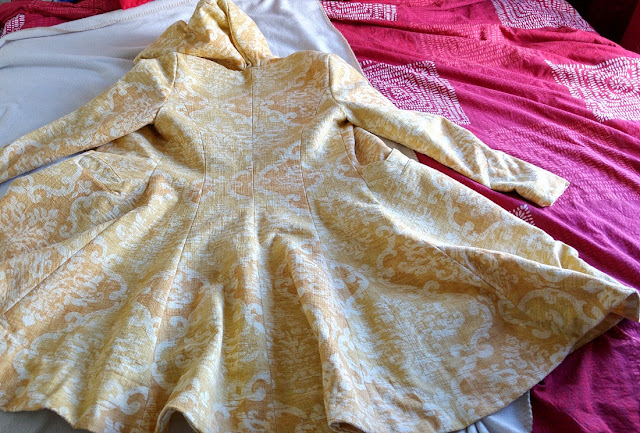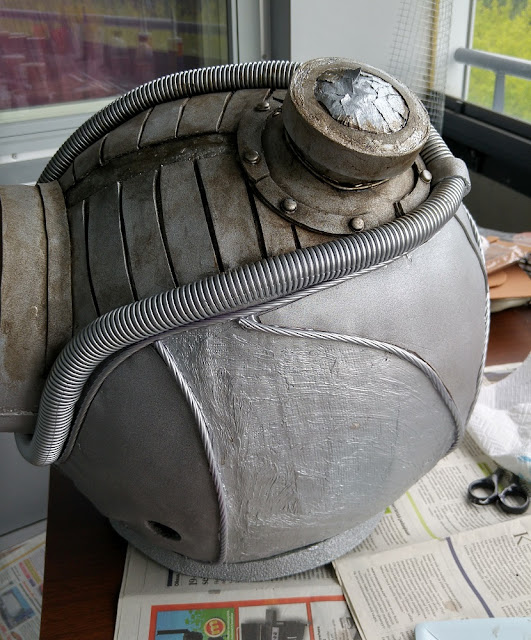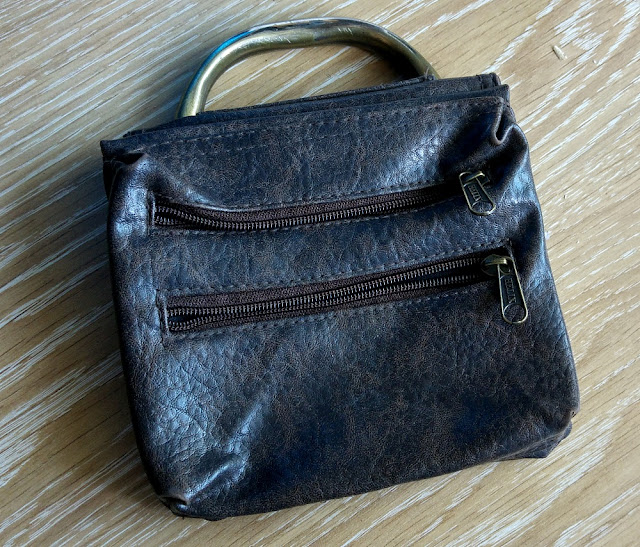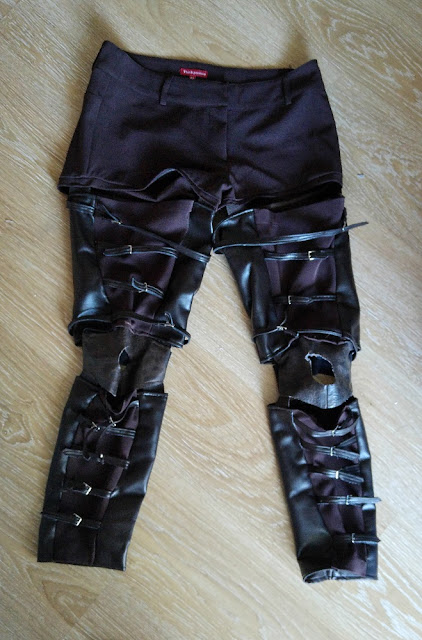Hey everyone,
Fall is fast approaching, as the crazy rain and wind have proven several times within the last few weeks. So, I thought about making a coat for cold weather - something perhaps not quite as thick and wintery as the one I made in January, but something for the fall anyway.
I'd had the fabric I used for this project for quite some time... About a year ago, I found 5 meters of this fabric with yellow and orange print in a local secondhand store for 5 euros. "1 euro per meter," I thought, "that's cheap as dirt. I'm sure I'll use this fabric for something at some point."
The fabric is thick and has a nice texture to it - it's probably meant for curtains or upholstery? It had a brand name (Harlequin) on it, and it also said "printed in the UK" on the selvage. I couldn't find this particular print anywhere on their website, so apparently it's an older design.
I also had purchased this secondhand (70s? 80s? 90s?) dress pattern at some point for 25 cents. I didn't like the dress as-is, because it was just so... well, awful? :D
So why buy a pattern I don't like? Simple: I buy cheap, uncut patterns in secondhand stores and use them as pattern paper when I need some. I just draw my own pattern onto the paper, and sometimes I can use parts of the original pattern, like the armhole curve and sleeve and whatnot. But most of the time I just ignore the original pattern and use the paper as if it were blank.
However, when I unfolded the pattern, the pattern pieces looked very, very similar than the pieces I myself had drawn from scratch for my first coat in January! I actually dug out that pattern and compared the pieces, and what do you know, aside from minor details they were almost identical, even in size! Whaaaaaaat. Perhaps this pattern wasn't so awful after all? :D
So I decided to use the pattern pieces, well, with slight modifications.
I'd gotten inspired by all kinds of pocket designs I'd seen on Pinterest, and that's why I cut the front pieces like that. I had no idea if the pattern I made was going to work the way I imagined, or how it would be assembled if it worked, but I decided to try anyway. After all, all I could lose was 5 euros and some of my time. I modified the center front pieces to include lapels, which the original dress pattern didn't have, and I also made the hem wider. The back pieces I used almost as-is, I simply cut them wider at the hem as well. The sleeves were used as-is aside from length (I added ~15cm of length because my arms are super long, just like my legs. Essentially, I'm just a pile of super long limbs with a torso hiding somewhere in the middle.)
The fabric print was one-way (it helpfully said "TOP --->" in the selvage, pointing which way was up), so I had to place the pattern pieces on the fabric in a rather wasteful way. This didn't matter much, though, because there was 5 meters of fabric to use.
I cut the pieces out one by one (not on fold), because the front piece was too wide to cut when the fabric was folded. This left me with a lot of scraps (I used some for pocket bags, facings and such) and a good meter for the hood pieces. Perfect!
I interfaced all the small pieces, like pockets and facings, and also shoulder seams, armholes, lapels etc with iron-on interfacing. After interfacing (the most boring task while making a coat in my opinion) was done, I could sew my pocket idea together. So how it worked was that I sewed two of those pocket top pieces right sides together at the top of the v-shape. I turned this the right side out, ironed and top-stitched. Then I sewed this piece and the pocket bag onto the front piece of the coat, right sides together. The coat was right side up, on top of that was the top piece (the "v") of the pocket, right side down, and lastly on top was the pocket bag, right side down. This was kind of difficult because the V of the pocket top in between the other layers was upside down at this point, so its edges went in different direction than the pocket edge and the edge of the pocket bag. So I had to sew down one side of the V, then readjust the V-shaped piece so the raw edges met again.
I was so concentrated on this part that there aren't any photos, but I made this awful drawing that might or might not clarify the process a bit:
When I'd connected the top V and the pocket bag to the front piece, I flipped the pocket bag on the inside of the front piece and ironed + top-stitched everything so it stayed in place.
After this, I sewed together the front center and the side front pieces. (I'd left the side front pieces long enough to act as the other half of the pocket bag). Placing the pieces right sides together, I sewed down from the armhole curve along the princess seam until I reached the V of the pocket. Then I flipped the front center piece out of the way and continued sewing the side piece on the pocket bag only. After this was done, I had a pocket with no visible seams on the outside of the coat.
I repeated the process on the other front pieces, then pieced together the backside of the coat.
I sewed the front and the back together at the shoulders and side seams, attached the sleeves, and it was starting to look like a coat:
Next I cut out the lining:
The lining was also a secondhand fabric (2 euros). There wasn't quite enough of it, so I had to cut the sleeves from another fabric (so they're red, but it's not like they're going to be visible anyway).
Since I didn't need to repeat my pocket escapades on the lining side, I simply sewed the front lining pieces together like this:
The lining assembled (without sleeves):
Onwards to the hood!
My hood pieces looked like this:
I traced the neckline of the coat while it was folded in half (so that the center back seam was on the other side and the front lapels on the other). I then drafted the hood and cut it out. I then realized that the hood was too small for me and I didn't have enough fabric to cut new hood pieces (I needed four because the hood would be fully lined). So I cut a strip of fabric that was sewn between the hood pieces. It made the hood the size I needed, plus it ended up looking rather nice for a mistake so I'm not complaining. :D
Here's one half of the hood sewn together:
When I had two identical hoods, I simply sewed them right sides together at the front, flipped the hoods right side out and top-stitched near the edge. Then I sewed the hood on around the neckline, along with the neckline facing and some bias tape from which to hang the coat.
In the above picture, you can spot some pins on the coat front. I realized too late I'd made the middle front pieces too wide, so the coat sagged across my chest. I'd already attached the lapel facings, and since I'm lazy and don't want to seam-rip if I can avoid it, I fixed this by making identical pleats on both sides and top stitched them down so the coat would fit me. My lazy seamstress hack worked, and the pleats actually add a nice visual detail on the coat. As for the lining, I simply trimmed the excess off the mid-center of the pieces before attaching it to the lapel facings.
Before I could attach the lining, I had to make buttonholes in the lapel. I made three triangular bound buttonholes as shown in this tutorial and three triangular holes on the backside of the lapel.
Then I hand-sewed the front and the back of the buttonholes together.
With the buttonholes done, I could now attach the lining. Right sides together, I sewed the neckline first, then down the lapels. I turned the coat inside out through the not yet finished hem, dug the sleeves out and attached them next. The hem was finished with a wide facing.
I used the fabric scraps to cover some buttons (I used the same set of buttons I used for my last coat as well), put the coat on to see where the buttons would go, and hand-sewed them on.
And the coat was finished!
And here's how it looks worn:
I didn't keep tabs on how long it took me to finish this coat, but I made it over the course of four days (but I wasn't sewing all day every day). If I had to guesstimate, this coat probably took me something like 20-30 hours to make.
The fabrics for this project, including iron-on interfacing, cost 15 euros altogether. All fabrics except for the interfacing (and the red fabric for the lining sleeves that was leftover from my husband's cosplay) were purchased secondhand.
The buttons cost about 1 euro, as they were from a package I think cost like 2-3 euros.
I can't accurately calculate how much thread, electricity etc I used while making this coat, but all in all, this project probably cost me around 20 euros (not including the time and effort, of course).
20 euros for this coat? Not bad at all. Or what do you think? :)
Satu / Sew Scoundrel






























































